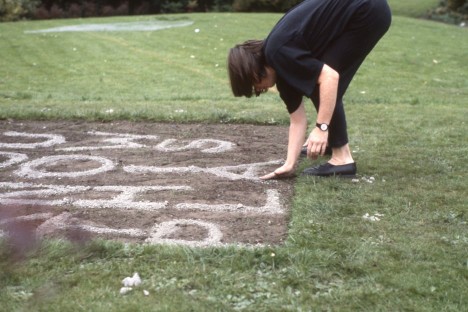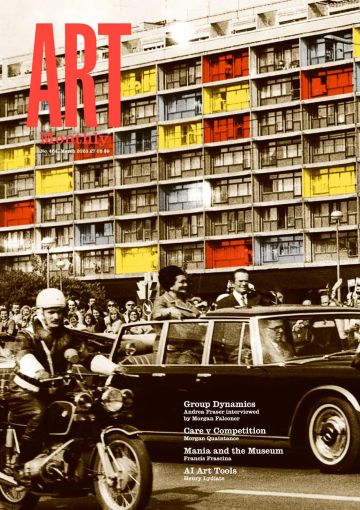Review
A Tall Order! Rochdale Art Gallery in the 1980s
Eddie Chambers argues that the contributions of regional public galleries in the 1980s raises questions about their impact today

Anne Tallentire, Do You Know This Place, 1990
Ikon Gallery was the first gallery to offer a dedicated look back at its curatorial activities during the 1980s with ‘As Exciting As We Can Make It: Ikon in the 1980s’, which took place in the summer of 2014. Featuring artists such as Rasheed Araeen, Art & Language, Kevin Atherton, Susan Hiller, Cornelia Parker, Sean Scully and Richard Wilson, the exhibition was an important reminder of the leadership roles a gallery can take, in both representing and facilitating artists’ practices, over the breadth of a decade. Now, nearly a decade later, another important gallery – this time in the north of England – offers its appraisal of the ways in which it too represented and facilitated a wide range of artists’ practices. Though the time span attended to in ‘A Tall Order! Rochdale Art Gallery in the 1980s’ has a certain elasticity (it includes work made by artists such as Shezad Dawood, who was born in 1974, and Michelle Williams Gamaker, who was born in 1979), the central focus of the exhibition is the extraordinary curatorial work the gallery did during the 1980s.
The exhibition can perhaps be located within a discernible fixation with the 1980s, as evidenced in exhibitions such as Nottingham Contemporary’s ‘The Place is Here’ (Reviews AM404), because the publicity material for ‘A Tall Order!’ reiterates familiar, oft-quoted material: ‘During the 1980s, Britain was marked by major social and political events including the Falklands War, the Troubles in Northern Ireland, racial tensions and riots in several British cities, the Miners’ Strike, anti-nuclear protests at Greenham Common Women’s Peace Camps, and prejudice against LGBQT+ communities in the face of the AIDS crisis and Section 28. All of these were reflected in Rochdale Art Gallery’s exhibition programming, and the gallery became well-known for its engagement with “issue-based art”.’
This was not quite the full premise of ‘A Tall Order!’, however: just as Ikon Gallery’s exhibitions of the 1980s came about in no small part as a result of the vision of Antonia Payne, so Rochdale Art Gallery’s visionary and socially conscious programming was a direct result of important work undertaken by Jill Morgan, who helmed the institution for 12 years from 1981 to 1993. But Morgan did more than take a lead, working as she did at different times with a small team that included Bev Bytheway, Lubaina Himid and Maud Sulter. Indeed, Himid and Sulter were in part responsible for sharing important exhibition opportunities with artists such as Donald Rodney, whose show ‘Critical’, in May and June of 1990, was an early career retrospective at Rochdale Art Gallery.
‘A Tall Order!’, researched and curated by Derek Horton and Alice Correia, is installed across four galleries, each with a particular though, perhaps, necessarily broad theme around which the 90+ artists in the exhibition were grouped: Gallery One, ‘Work and Labour’; Gallery Two, ‘Land and Our Environment’; Gallery Three, ‘Rochdale at the Heart of Everything’; Gallery Four, ‘Power, Identity, and Representation’. Paradoxically, an exhibition with aspirations for such breadth results in some artists’ contributions being, in essence, overlooked by the casual viewer. But, in navigating so much work by so many artists, visitors to ‘A Tall Order!’ will likely be persuaded that Morgan et al undertook important, socially engaged exhibition programming that both served and recognised the gallery’s broader constituencies of visitors.
It would be a disservice to ‘A Tall Order!’ were it to be reductively caricatured as another homage to the 1980s. An important strand of the exhibition is its examination of the growth and the building of Rochdale as a strong northern town with a distinct architectural character, as evidenced in the inclusion of Charles Donald Taylor’s painting The Construction of College Bank Flats, Rochdale, Lancashire, 1966, and a set of six gritty monochrome photographs by John Davies of views of Rochdale taken in the 1980s when the town’s identity as an industrial heartland was being put under severe pressure. A corresponding set of photographs taken by Malcolm Glover, again in the monochrome printing that continued to be both popular and affordable in the 1980s, document the emergence of Rochdale as a settled place of residence to generations of people of South Asian background: at home, at work and at places such as the barbershop. Surprisingly perhaps, there is a far greater arc of art history in ‘A Tall Order!’, including, for example, works such as Victorian painter Frederick Goodall’s Shepherdess and Her Flock at a Pool Left by the Subsiding of the Overflow of the Nile, 1888. Historical paintings such as these were evidence of the scope and singularity of Morgan’s vision. The label accompanying Goodall’s painting made mention of it being included in a 1990 exhibition, ‘The Sands of Time’, ‘which sought to question western European perceptions of colonised countries’.
Thus, the inclusion of other ‘historical’ paintings, such as Lancelot Myles Glasson’s The Young Rower, 1932, and Gerald Festus Kelly’s Saw Ohn Nyun IV, 1932–44, gives ‘A Tall Order!’ particular depth, breadth and gravity. These two particular works were included in Morgan’s 1982 undertaking ‘Object Art/Object d’Art’, a display of works from Rochdale’s permanent collection, which ‘sought to re-examine some of the most popular works owned by the gallery, and question their meaning for contemporary audiences’. While visitors to ‘A Tall Order!’ might not be surprised to learn that by 1982 ‘the voyeurism [of The Young Rower] was regarded as “obscene to young feminists’, this particular visitor was finally able to identify Kelly’s artwork as the painting-in-the-painting of Lesley Sanderson’s 1988 work Time for a Change, in which this Sheffield-based artist undertook to challenge gendered and racialised objectification uncompromisingly in one of her memorable portraits/self-portraits. Time for a Change and other works, including Sutapa Biswas’s Que Sera Sera, 1985–86, and The Only Good Indian, 1985–86 (Interview AM447), were featured in important exhibitions at Rochdale Art Gallery such as ‘The Issue of Painting’ in 1986, which not only sought to give supportive space to the practices of women artists but also to recognise that these artists had as much right to call themselves painters as any white male artist, to whom the term overwhelmingly tended to be associated.
Inevitably, for those of a certain age, it is difficult to resist a not unproblematic sense of nostalgia for the gripping, innovative and sometimes technologically savvy art practices of a decade that had more than its fair share of bad news stories, the worst of them being the multiple election victories of the Tory Party. One of the galleries, Gallery Two, ‘Land and Our Environment’, includes a tape slide presentation by Anne Tallentire. The rhythmic sound of the slides changing in the carousel permeated the gallery, reminding those of us, again of a certain age, of the ubiquity of the programmed slide carousel that was such a perennial presence in no end of exhibitions from the mid 1980s to the early 1990s.
Ultimately, ‘A Tall Order!’ raises a number of important questions. Rochdale Art Gallery was not alone in its profile as a local authority-funded gallery that had placed a certain activism at the centre of its mission of public provision. Galleries such as nearby Oldham Art Gallery, the Harris Museum in Preston, Liverpool’s Bluecoat and Wolverhampton Art Gallery all had, in their own ways, a commitment not only to recognising wider constituencies of practitioners and the ambitions of emerging black and brown curators, but also, and equally importantly, a commitment to seeking to ensure that these venues were welcoming spaces for townspeople to visit. Such galleries continue to maintain socially conscious agendas, and yet, collectively and individually, their profiles, which were particularly high in the 1980s, seem to have markedly subsided since. Why is that? We might also ask why it was that local art galleries in the Midlands and the north of England, whose local authority budgets were already under pressure, were able to undertake such consistently innovative programming and to present themselves as protective cultural environments that both resisted and recognised the ravages of a hostile, xenophobic, homophobic central government that cared nothing for the safeguarding of northern working-class communities of different ethnicities. (It should be noted that the Arts Council was a source of financial support for a great many exhibitions, in galleries across the north and the Midlands during the latter part of the 1980s.)
It would certainly be somewhat blinkered to imagine that ‘A Tall Order! Rochdale Art Gallery in the 1980s’ could only be viewed through the prism of the achievements of Morgan et al. Though Rochdale Art Gallery emerges as a pioneering venue, this exhibition can, most importantly, be read as inviting us to recall other activist curators and arts administrators working in other northern galleries during the 1980s.
Eddie Chambers is holder of the David Bruton, Jr centennial professorship in art history at the University of Texas, Austin and is an honorary patron of Art Monthly.
‘A Tall Order! Rochdale Art Gallery in the 1980s’, Touchstones, Rochdale, 4 February to 6 May 2023
First published in Art Monthly 464: March 2023.











